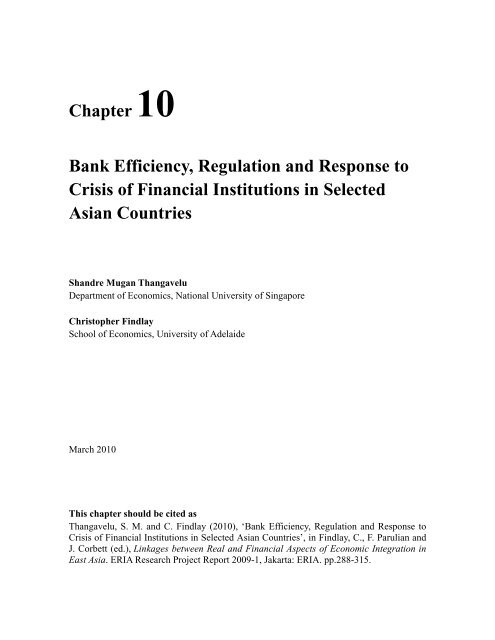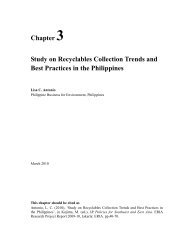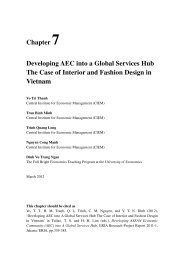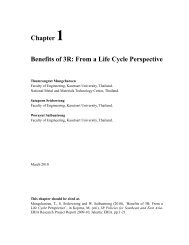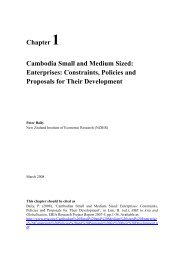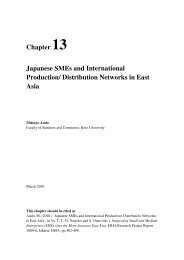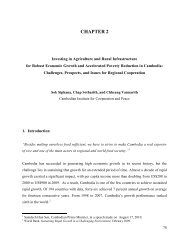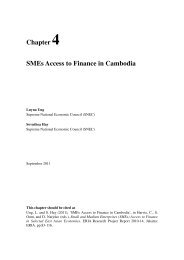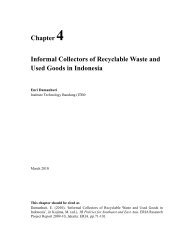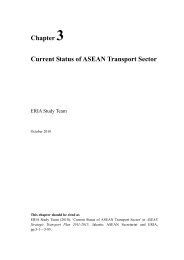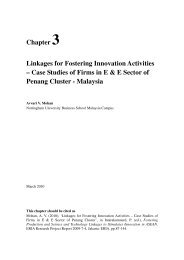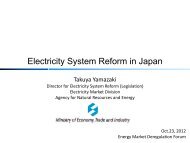Bank Efficiency, Regulation and Response to Crisis of ... - ERIA
Bank Efficiency, Regulation and Response to Crisis of ... - ERIA
Bank Efficiency, Regulation and Response to Crisis of ... - ERIA
You also want an ePaper? Increase the reach of your titles
YUMPU automatically turns print PDFs into web optimized ePapers that Google loves.
financial markets tends <strong>to</strong> reduce bank efficiency. The results <strong>of</strong> the paper indicate thatbank regulation <strong>and</strong> supervision will be crucial <strong>to</strong> improve the efficiency <strong>of</strong> the banks<strong>and</strong> stability in the financial markets in the Southeast Asia.Keywords: banking efficiency, regulation, supervision, <strong>of</strong>f-balance sheetJEL Classifications: G18, G21, G28289
egulation on bank efficiency. One <strong>of</strong> the objectives <strong>of</strong> bank regulation is <strong>to</strong> managecompetition <strong>and</strong> risk-taking activities in the financial sec<strong>to</strong>r. In this case, bankregulation tends <strong>to</strong> retard competition <strong>and</strong> innovative activities <strong>of</strong> financial institutions,thereby affecting the efficiency <strong>of</strong> financial institutions. Recent studies highlight thepositive impact <strong>of</strong> regulation on banking activities in terms <strong>of</strong> increased marketmoni<strong>to</strong>ring <strong>and</strong> a better-quality contracting environment, which has a positive impact onbank efficiency (Gonzales, 2009). In this paper, we study the impact <strong>of</strong> bank regulation<strong>and</strong> supervision on bank efficiency in terms <strong>of</strong> the regulation <strong>of</strong> the activities thatgenerate non-interest income, the intensity <strong>of</strong> moni<strong>to</strong>ring <strong>of</strong> banks by private sec<strong>to</strong>rorganizations, <strong>and</strong> the extent <strong>of</strong> <strong>of</strong>ficial supervision by the central bank. To ourknowledge, this is the first paper <strong>to</strong> address the impact <strong>of</strong> bank regulation <strong>and</strong>supervision on bank efficiency for Southeast Asian banks.The paper also studies the impact <strong>of</strong> financial market liberalization, in terms <strong>of</strong> openingup the financial sec<strong>to</strong>r <strong>to</strong> foreign participation <strong>and</strong> foreign ownership, on the efficiency<strong>of</strong> financial institutions. Foreign banks are generally restricted in entry <strong>and</strong> operations inAsia, <strong>and</strong> the penetration <strong>of</strong> foreign banks in Asia is much lower than in Central Europe<strong>and</strong> Latin America (Montgomery, 2003). Foreign banks in Asia are restricted incommercial lending activities <strong>and</strong> limited <strong>to</strong> a few branches in comparison <strong>to</strong> the localbanks. For example, in Indonesia, foreign banks are restricted geographically in lendingactivities in the Jakarta region <strong>and</strong> in taking time deposits. In most Asian countries,foreign banks are restricted in access <strong>to</strong> the Central <strong>Bank</strong> discount window <strong>and</strong> <strong>to</strong>subsidized trade credit facilities. In Korea, foreign banks are allowed <strong>to</strong> operate onlyrestricted branches within the city area, thereby restricting their access <strong>to</strong> local currencydeposits; <strong>and</strong> the <strong>to</strong>tal amount <strong>of</strong> deposit they can accept is also restricted (Montgomery,2003).The impact <strong>of</strong> financial market liberalization is an important talking point following theexperience <strong>of</strong> the Asian <strong>Crisis</strong> in 1997. Following the <strong>Crisis</strong>, Singapore liberalized itsfinancial sec<strong>to</strong>r by increasing the foreign ownership <strong>and</strong> participation <strong>of</strong> foreign banksin the domestic economy. In contrast, Malaysia adopted capital controls that limited theflow <strong>of</strong> capital <strong>and</strong> also the role <strong>of</strong> foreign participation in the financial <strong>and</strong> domestic291
markets. Malaysian policies are argued by some <strong>to</strong> have led in the short run <strong>to</strong> a fastereconomic recovery, smaller decline in unemployment <strong>and</strong> wages, <strong>and</strong> a more rapidturnaround <strong>of</strong> the s<strong>to</strong>ck market (Kaplan <strong>and</strong> Rodrik, 2001). However, there is no clearevidence <strong>of</strong> the impact <strong>of</strong> capital controls in the long run on bank efficiency. Anunderst<strong>and</strong>ing <strong>of</strong> the impact <strong>of</strong> foreign participation on the productive performance <strong>of</strong>banks in the long term is valuable. A recent study by Kose et al. (2009) also shows thatfinancial openness has a robust positive impact on TFP growth in the domestic economy.A study by Xu (2010) provides strong empirical evidence that foreign entry led <strong>to</strong> amore competitive <strong>and</strong> efficient banking industry in China. However, Obstfeld (2009)says that there is little evidence <strong>of</strong> a direct positive impact <strong>of</strong> financial openness on theeconomic welfare <strong>of</strong> developing countries. The paper studies the impact <strong>of</strong> foreignownership <strong>and</strong> participation in the financial markets on individual bank efficiency.Our study further examines the impact <strong>of</strong> the <strong>of</strong>f-balance sheet activities <strong>of</strong> banks ontheir efficiency. Increasingly, banks are using <strong>of</strong>f-balance sheet activities in pursuit <strong>of</strong>higher pr<strong>of</strong>its <strong>and</strong> <strong>to</strong> satisfy the increase in dem<strong>and</strong> for non-banking products bycus<strong>to</strong>mers. These <strong>of</strong>f-balance sheet activities could be associated with excessive risktaking, which subsequently affects efficiency. There is little research that examinesfinancial innovation in terms <strong>of</strong> the <strong>of</strong>f-balance sheet activities <strong>of</strong> Southeast Asian banks<strong>and</strong> this study fills this gap. This is particularly relevant in the context <strong>of</strong> the experience<strong>of</strong> the global financial crisis.Finally, this work contributes <strong>to</strong> the underst<strong>and</strong>ing <strong>of</strong> the risk <strong>of</strong> the misallocation <strong>of</strong>funds by banks arising from the moral hazard issues associated with state influence <strong>and</strong>guarantees (Radelet <strong>and</strong> Sachs, 1998). We used a bank’s equity-<strong>to</strong>-asset ratios <strong>and</strong> itscorporate linkages, via its own ownership structure or its links <strong>to</strong> subsidiaries, <strong>to</strong> capturethe impact <strong>of</strong> the related moral hazard issues on productive performance.The chapter is organized as follows. Section 2 discusses the methodology, <strong>and</strong> theconstruction <strong>of</strong> the data is presented in Section 3. The results are presented in Section 4<strong>and</strong> the conclusion in Section 5.292
2. Empirical MethodologyThe paper adopts panel data framework <strong>to</strong> study the determinants <strong>of</strong> bank efficiency.The regression equation is given as:<strong>Bank</strong>-Efficient it = 0 + 1 Fin it + 2 Reg it + 3 Types it + i t it1where <strong>Bank</strong>-Efficient it is the bank efficiency measure <strong>of</strong> bank i in year t; Fin it is the se<strong>to</strong>f specific characteristics <strong>of</strong> <strong>Bank</strong> i in year t; Reg it is the set <strong>of</strong> bank regula<strong>to</strong>ry <strong>and</strong>supervision variables; Types it captures the bank types; θ t are dummies <strong>to</strong> capture anyunobserved bank-invariant time effects not included in the regression; i areunobservable bank-specific effects that vary across the banks but are constant over time;<strong>and</strong> it are white-noise error terms.We adopt fixed-effects <strong>and</strong> r<strong>and</strong>om-effects <strong>to</strong> estimate Equation (1). It is very likely thatthere are endogeneity problems in Equation (1) in terms <strong>of</strong> reverse causation, wherebybank regulation <strong>and</strong> supervision might be responding <strong>to</strong> the efficiencies <strong>of</strong> the bank.Thus, failure <strong>to</strong> account for the simultaneity problems might lead <strong>to</strong> biased estimation<strong>and</strong> coefficients. 2 To address this problem we adopt the two-stage least squarefixed-effects (FE2SLS) <strong>and</strong> two-stage least square r<strong>and</strong>om-effects estima<strong>to</strong>rs (RE2SLS)as provided by Baltagi (2001). Both FE2SLS <strong>and</strong> RE2SLS are expected <strong>to</strong> control forthe presence <strong>of</strong> unobservable bank-specific effects <strong>and</strong> potential endogeneity <strong>of</strong> bankefficiency.3. Data <strong>and</strong> Construction <strong>of</strong> Variables3.1. DataThe main bank level data for the study is obtained from <strong>Bank</strong>Scope Database.<strong>Bank</strong>-level information <strong>to</strong> estimate bank efficiency is taken from <strong>Bank</strong>Scope Database.All data used are expressed in 1996 US dollar terms <strong>and</strong> consolidated bank balance2 The FE2SLS <strong>and</strong> RE2LS estimations are expected <strong>to</strong> correct for the key endogeniety problems in theestimation such as those related <strong>to</strong> bank regulation <strong>and</strong> supervision <strong>and</strong> also any endogeniety effects fromthe TE-TA ratio.293
estimated. A comparison between this optimal level <strong>of</strong> inputs required <strong>and</strong> the actuallevel <strong>of</strong> inputs each producer uses will yield an efficiency measure for eachdecision-making unit. The output-oriented approach is similar, except that the inputs arekept fixed at the current levels <strong>and</strong> the maximum amount <strong>of</strong> outputs that can beproduced at those levels <strong>of</strong> inputs will be estimated <strong>and</strong> compared against the actuallevels <strong>of</strong> outputs <strong>of</strong> each producer. In the estimation <strong>of</strong> the efficient frontier, eitherconstant returns <strong>to</strong> scale (CRTS) or variable returns <strong>to</strong> scale (VRTS) can be assumed.DEA efficiency scores ranges between 0 <strong>and</strong> 1, with 1 being fully efficient.DEA has several advantages in terms <strong>of</strong> its application <strong>to</strong> the financial sec<strong>to</strong>r. It does notrequire knowledge <strong>of</strong> the explicit functional form or assumptions with regard <strong>to</strong> itss<strong>to</strong>chastic error terms, which is particularly important as it is difficult <strong>to</strong> define thefunctional forms <strong>of</strong> bank production. Nor does it require a large sample size <strong>to</strong>implement. In this study we adopt the input orientation <strong>to</strong> measure the efficiency <strong>of</strong>each bank with the assumptions <strong>of</strong> constant (Input CRS) <strong>and</strong> variable returns <strong>to</strong> scale(Input VRS). As in Berger <strong>and</strong> Mester (1997), DeYoung <strong>and</strong> Nolle (1998) <strong>and</strong> Gonzales(2009), we used three inputs – personnel expenses, book value <strong>of</strong> fixed assets <strong>and</strong>loanable funds (sum <strong>of</strong> deposits <strong>and</strong> non-deposit funds) – <strong>and</strong> two outputs – <strong>to</strong>tal loans<strong>and</strong> non-interest income. In this approach, a frontier is calculated for each individualcountry <strong>and</strong> a bank’s efficiency is measured relative <strong>to</strong> its country’s own frontier (banksare equally weighted).The average bank efficiency measure using DEA for the selected Southeast Asiancountries is given in Table A2 in the Appendix. Indonesia, Malaysia <strong>and</strong> Vietnam haveexperienced low levels <strong>of</strong> bank efficiency among the countries in the sample. In fact, thebank efficiency for Vietnam is lowest among the six Southeast Asian countries whileSingapore <strong>and</strong> the Philippines have the highest. It is interesting <strong>to</strong> notice that thebanking efficiency <strong>of</strong> Malaysia is lower than that <strong>of</strong> Indonesia <strong>and</strong> Thail<strong>and</strong>, <strong>and</strong> is adeclining trend over time except for 1999–2003. It will be interesting <strong>to</strong> examine if thisresult is due <strong>to</strong> the capital controls <strong>and</strong> restrictions on foreign participation imposed byMalaysia since 1998 after the Asian <strong>Crisis</strong>. We also notice that banking efficiency isdeclining for all Southeast Asian banks except for Vietnam. Although the bank295
efficiency measures for the Philippines, Singapore <strong>and</strong> Thail<strong>and</strong> are relatively high, theyalso declined in recent years.In this paper, we adopt the two-stage framework <strong>to</strong> study the determinants <strong>of</strong> bankefficiency. The efficiency measure derived from DEA in the first stage is used as anindependent variable in the second stage. Recent studies by <strong>Bank</strong>er <strong>and</strong> Natarajan(2008), Simar <strong>and</strong> Wilson (2007) <strong>and</strong> Souza <strong>and</strong> Staub (2007) highlight that thetwo-stage analysis using DEA is viable <strong>and</strong> under certain conditions can even capturethe nonparametric s<strong>to</strong>chastic efficiency results.Our measure <strong>of</strong> efficiency is based on activity, particularly loans <strong>and</strong> other bankingactivities that earn a fee, <strong>and</strong> might better be described as a productivity or technicalefficiency measure. A more complete measure <strong>of</strong> efficiency would be based on pr<strong>of</strong>itsor margins, <strong>and</strong> that extension is a <strong>to</strong>pic for further work, which may also involve theapplication <strong>of</strong> other estimation methods, such as a s<strong>to</strong>chastic frontier.3.2.2. <strong>Bank</strong> regulation <strong>and</strong> supervisionThe study used three key regula<strong>to</strong>ry <strong>and</strong> supervisory variables. The variable RESTRICTmeasures the extent <strong>of</strong> bank regulations that restrict activities that generate non-interestincome. This variable indicates if bank activities in the securities, insurance, <strong>and</strong> realestate markets <strong>and</strong> bank ownership <strong>and</strong> control <strong>of</strong> nonfinancial firms are unrestricted,permitted, restricted or prohibited. Higher values indicate a higher level <strong>of</strong> restrictions.The bank supervision variables are represented by the intensity <strong>of</strong> private moni<strong>to</strong>ring(MONITOR) <strong>and</strong> <strong>of</strong>ficial supervision <strong>of</strong> banks (OFFICIAL). Both variables werederived as given in Barth, Caprio <strong>and</strong> Levine (2004, 2006). The MONITOR indexcontains information regarding the external auditing <strong>of</strong> banks, ratings by internationalagencies, the availability <strong>of</strong> an explicit deposit insurance scheme, <strong>and</strong> the disclosure <strong>of</strong>risk-management procedures <strong>to</strong> the public. The OFFICIAL index provides informationregarding the extent <strong>to</strong> which regula<strong>to</strong>rs have the authority <strong>to</strong> take regula<strong>to</strong>ry actions.Higher values for MONITOR <strong>and</strong> OFFICIAL indicate greater private oversight <strong>and</strong>more <strong>of</strong>ficial supervisory power, respectively.296
3.2.3 Specific Characteristics <strong>of</strong> Financial InstitutionsWe used several variables <strong>to</strong> capture specific banking activities that could directly affectthe productive performance <strong>of</strong> banks. Several studies have highlighted the importance<strong>of</strong> capital requirements. Higher capital requirements will have a direct impact on therisk-taking activities <strong>of</strong> the owners <strong>of</strong> the bank. To capture this effect, we introduced the<strong>to</strong>tal equity <strong>to</strong> <strong>to</strong>tal assets ratio (TE_TA). To capture the liquidity effects <strong>of</strong> the banks weused loan loss reserve <strong>to</strong> <strong>to</strong>tal loans ratio (LOANLR_GL), liquid assets <strong>to</strong> <strong>to</strong>tal assetsratio (LA_TA), <strong>and</strong> non-earning assets <strong>to</strong> <strong>to</strong>tal assets ratio (NEA_A). To account for the<strong>of</strong>f-balance sheet activities <strong>of</strong> banks, we used <strong>of</strong>f-balance sheet <strong>to</strong> <strong>to</strong>tal assets ratio(OFFBAL_A).The impact <strong>of</strong> foreign ownership <strong>and</strong> partnership on bank performance is given by adummy variable, FOREIGN, which represents majority foreign ownership <strong>of</strong> more than50 percent equity ownership <strong>of</strong> the banks. We also show whether the bank is a publicbank (PUBLIC), wherein the government has more than 25 percent ownership. Tocapture the moral hazard issues related <strong>to</strong> banks taking ownership <strong>of</strong> banks <strong>and</strong> privatecompanies taking ownership <strong>of</strong> banks, we introduce the dummy variable SUBSIDIARYthat indicates if the bank is a subsidiary or if it has a subsidiary. We also introducedummy variables <strong>to</strong> capture the types <strong>of</strong> banking activities <strong>of</strong> the bank.4. Results: Determinants <strong>of</strong> <strong>Bank</strong> <strong>Efficiency</strong>The key trends <strong>of</strong> TE_TA (ratio <strong>of</strong> <strong>to</strong>tal equity <strong>to</strong> <strong>to</strong>tal assets ratio), LOANLR_GL (loanloss reserve <strong>to</strong> <strong>to</strong>tal loans ratio), LA_TA (liquid assets <strong>to</strong> <strong>to</strong>tal assets ratio), NEA_A(non-earning assets <strong>to</strong> <strong>to</strong>tal assets ratio) <strong>and</strong> OFFBAL_A (<strong>of</strong>f-balance sheet <strong>to</strong> <strong>to</strong>talassets ratio) are given in Table A3 in the Appendix. We also present the plots <strong>of</strong> TE_TA,LOANLR_GL, LA_TA, <strong>and</strong> NEA_A in Figures A1 <strong>to</strong> A5. In Figure A1, TE_TA tends <strong>to</strong>fall in the Asian crisis period <strong>of</strong> 1997–1999 <strong>and</strong> then increase during the post-crisisperiod <strong>of</strong> 2000–2008. Singapore <strong>and</strong> Thail<strong>and</strong> increase their <strong>to</strong>tal equity <strong>to</strong> <strong>to</strong>tal assetsratio by nearly 20 percent in 2000–2008. The other selected ASEAN countries <strong>of</strong>Malaysia, Indonesia, The Philippines <strong>and</strong> Vietnam also increase their TE_TA ratio bynearly 15 percent. In particular, Indonesia experienced a TE_TA ratio <strong>of</strong> less than 5297
percent in 1997–1999, which increased <strong>to</strong> nearly 15 percent in 2000–2008.The LOANLR_GL ratio tends <strong>to</strong> increase during an economic crisis, which is shownclearly among the ASEAN countries in Table A2. Most ASEAN countries increasedtheir LOANLR_GL ratio in 2000–2008 by nearly 10 percent except Vietnam. Thehigher LOANLR_GL indicates that the financial institutions are holding higher liquidityreserves <strong>to</strong> ride volatility in output in the post-Asian crisis period. The higher liquidityassets holding is also reflected by the liquidity assets <strong>to</strong> <strong>to</strong>tal assets ratio (LA_TA ratio)for Malaysia in Figure A3, which shows that it is holding more than 25 percent <strong>of</strong> liquidassets <strong>to</strong> <strong>to</strong>tal assets. In comparison, the other countries are holding more than 15percent <strong>of</strong> liquid assets <strong>to</strong> <strong>to</strong>tal assetsIn Figure A4, the non-earning assets <strong>to</strong> <strong>to</strong>tal assets (NE_A) is nearly 30 percent forMalaysia in 2000–2008, indicating the vulnerability <strong>of</strong> the Malaysian financial marketsrelative <strong>to</strong> other ASEAN countries. The vulnerability <strong>of</strong> Malaysian financial markets isalso indicated in Figure A5, the <strong>of</strong>f-balance sheet <strong>to</strong> <strong>to</strong>tal assets ratio (OFFBAL_A).Although the <strong>of</strong>f-balance sheet <strong>to</strong> <strong>to</strong>tal assets ratio declined in 2000–2008, it remainednearly 25 percent for Malaysia. The other ASEAN countries experienced around 15percent <strong>of</strong> OFFBAL_A ratio.The results <strong>of</strong> the panel study are given in Tables 1 <strong>to</strong> 4. Tables 1 <strong>and</strong> 2 report theestimations based on the bank efficiency measurement using constant returns <strong>to</strong> scale(CRS) <strong>and</strong> variable returns <strong>to</strong> scale (VRS) using fixed- (FE) <strong>and</strong> r<strong>and</strong>om-effects (RE)specifications, respectively. To account for bank-specific effects <strong>and</strong> endogeneity issuesin our estimation, we adopted the two-stage least square estimation for fixed- (FE2SLS)<strong>and</strong> r<strong>and</strong>om-effects (RE2SLS) specifications proposed by Baltagi (2001). We used theliquid assets <strong>to</strong> <strong>to</strong>tal bank deposits <strong>and</strong> borrowing ratio, the sample size for DEAestimation, <strong>and</strong> types <strong>of</strong> banks as instrumental variables in the estimation. The results <strong>of</strong>FE2SLS <strong>and</strong> RE2SLS estimation are reported in Tables 3 <strong>and</strong> 4. The results <strong>of</strong> our studyare very consistent across both the fixed- (FE) <strong>and</strong> r<strong>and</strong>om-effects (RE) specifications.298
Table 1. Determinants <strong>of</strong> <strong>Bank</strong> <strong>Efficiency</strong> Based on Constant Returns-<strong>to</strong>-ScaleMeasure (CRS DEA–Input CRS) in Selected Southeast Asian <strong>Bank</strong>sFE(1) FE(2) RE(1) RE(2)TE_TA0.257**(2.280)0.283**(2.490)0.243**(2.540)0.242**(2.150)LOANLR_GL0.074(0.820)0.078(0.843)0.099(0.790)0.035(0.401)LA_TA0.009(0.140)0.051(0.701)–0.066(–1.140)0.019(0.390)0.135*– 0.116–NEA_A(1.710)(1.500)OFFBAL_A–0.011***(–7.220)–0.013***(–7.424)–0.010***(–5.300)–0.014***(–7.820)FOREIGN0.029***(3.531)0.032***(3.805)0.053***(5.660)0.023***(2.730)PUBLIC0.015(0.962)0.014(0.930)0.023(1.550)0.004(0.320)SUBSIDARY–0.089***(–4.063)–0.090***(–4.071)–0.117***(–6.600)–0.103***(4.800)RESTRICT0.107***(5.040)0.099***(5.210)0.097***(4.630)0.096***(4.530)MONITOR–0.495***(–15.500)–0.478***(–15.750)–0.464***(–15.350)–0.464***(–15.350)OFFICIAL0.088**(2.875)0.078**(2.780)0.077**(2.580)0.073**(2.460)Commercial <strong>Bank</strong>s 0.097***(3.975)0.106***(4.302)0.077(0.160)0.023(0.520)Investment <strong>Bank</strong>s 0.192*** 0.199***0.114** 0.125**Finance &SecuritiesCompanies(6.330)0.202***(5.280)(6.550)0.208***(5.260)(2.260)0.101*(1.610)(2.600)0.205**(2.355)Savings <strong>Bank</strong>s 0.072(1.306)0.073(1.290)–0.069(–0.710)–0.044(–0.650)Holding FinanceCompanies0.069**(2.510)0.074**(2.680)–0.023(–0.480)–0.011(–0.220)GovernmentSavings <strong>Bank</strong>s0.228***(5.510)0.232***(5.710)0.129**(2.170)0.147**(2.631)Islamic <strong>Bank</strong>s 0.222***(5.090)0.231***(5.320)0.100*(1.650)0.122**(1.920)Others 0.089**(2.020)0.094***(5.080)–0.015(–0.260)–0.086*(–1.690)Constant 1.710***(4.450)1.791***(5.080)1.851***(4.420)1.874***(4.650)Country Dummies Yes Yes Yes YesTime Dummies Yes Yes Yes YesR-Square 0.550 0.549 0.556 0.551Obs 1359 1359 1359 1359* 10 percent level <strong>of</strong> significance; ** 5 percent level <strong>of</strong> significance; *** 1 percent level <strong>of</strong> significance;t-Statistics in parenthesis; FE – Fixed Effects; RE – R<strong>and</strong>om Effects299
Table 2. Determinants <strong>of</strong> <strong>Bank</strong> <strong>Efficiency</strong> Based on Variable Returns-<strong>to</strong>-ScaleMeasure (Input VRS) in Selected Southeast Asian <strong>Bank</strong>sFE(1) FE(2) RE(1) RE(2)TE_TA0.408***(4.030)0.467***(4.170)0.370***(3.670)0.427***(5.310)LOANLR_GL0.192**(2.890)0.202***(2.940)0.148**(2.030)0.151(1.260)LA_TA0.023(0.330)0.115*(1.820)–0.0008(–0.130)0.080(1.330)0.304**– 0.266**–NEA_A(2.940)(2.870)OFFBAL_A–0.009***(–3.360)–0.013***(–5.470)–0.009***(–3.680)–0.013***(–3.810)FOREIGN0.038**(2.200)0.044***(2.410)0.036**(2.280)0.041**(2.080)PUBLIC0.011(0.470)0.011(0.440)0.003(0.150)0.004(0.180)SUBSIDARY–0.078***(–4.320)–0.081***(–4.610)–0.104***(–8.430)–0.103***(5.660)RESTRICT0.171***(7.110)0.153***(6.410)0.164***(7.620)0.148***(8.690)MONITOR–0.572***(–16.370)–0.533***(16.410)–0.548***(17.650)–0.515***(21.280)OFFICIAL0.189***(6.390)0.166***(5.610)0.179***(6.280)0.157***(6.060)Commercial <strong>Bank</strong>s 0.128***(4.190)0.146***(4.790)0.040(0.820)0.138***(4.510)Investment <strong>Bank</strong>s 0.176***0.192*** 0.099** 0.194***Finance &SecuritiesCompanies(4.130)0.185***(4.000)(4.250)0.195***(4.020)(2.170)0.093(1.470)(5.240)0.183**(4.020)Savings <strong>Bank</strong>s 0.066(1.310)0.068(1.230)–0.062(–0.810)0.024(0.390)Holding FinanceCompanies0.020(0.690)0.031(0.980)–0.069(–1.370)0.021(0.610)GovernmentSavings <strong>Bank</strong>s0.210***(5.700)0.217***(5.770)0.116**(2.200)0.204***(4.270)Islamic <strong>Bank</strong>s 0.209***(4.230)0.228***(4.830)0.0093**(2.170)0.196**(2.420)Others 0.097*(1.880)0.107**(2.050)–0.081(–1.450)0.092(1.080)Constant 0.490(1.400)0.676*(1.840)0.647*(1.760)0.741**(2.190)Country Dummies Yes Yes Yes YesTime Dummies Yes Yes Yes YesR–Square 0.521 0.518 0.524 0.525Obs 1359 1359 1359 1359* 10 percent level <strong>of</strong> significance; ** 5 percent level <strong>of</strong> significance; *** 1 percent level <strong>of</strong> significancet-Statistics in parenthesis; FE – Fixed Effects; RE – R<strong>and</strong>om Effects300
Table 3. Determinants <strong>of</strong> <strong>Bank</strong> <strong>Efficiency</strong> Based on Constant Returns-<strong>to</strong>-ScaleMeasure (Input CRS) Using IV Estimation in Selected Southeast Asian <strong>Bank</strong>sFE2SLSRE2SLS(1) (2) (3) (4)TE_TA0.606***(6.240)0.591***(8.260)0.567***(5.460)0.564***(5.560)LOANLR_GL0.117(0.820)0.113(0.640)0.060(0.340)0.060(0.430)LA_TA0.052(0.76)0.038(0.480)0.022(0.360)0.020(0.330)NEA_A– 0.049(0.330)– 0.008(0.070)OFFBAL_A–0.013***(–3.840)–0.013***(–3.230)–0.015***(–4.750)–0.015***(–4.130)FOREIGN0.028**(2.630)0.026**(2.550)0.019**(1.940)0.018*(1.670)PUBLIC0.011(0.710)0.012(0.790)0.001(0.120)0.002(0.110)SUBSIDIARY–0.091***(–3.580)–0.081***(–3.360)–0.094***(4.760)–0.095***(–4.020)RESTRICT0.112***(5.360)0.115***(4.260)0.179***(17.660)0.180***(15.750)MONITOR–0.502***(–16.080)–0.508(–11.700)–0.488***(–13.310)–0.490***(–12.530)OFFICIAL0.094***(3.110)0.098**(2.540)0.159***(7.900)0.160***(7.760)Commercial <strong>Bank</strong>s 0.089**(3.700)0.086***(3.160)0.103**(2.960)0.103**(2.990)Investment <strong>Bank</strong>s 0.164**(6.730)0.160***(5.780)0.184***(4.860)0.183***(5.180)Finance & SecuritiesCompanies0.201***(5.280)0.207***(5.071)0.220***(4.310)0.220***(4.810)Savings <strong>Bank</strong>s 0.263***(4.320)0.262***(3.870)0.250***(4.040)0.250***(4.250)Holding FinanceCompanies0.051**(1.980)0.048*(1.750)0.059(1.600)0.058*(1.710)Government Savings<strong>Bank</strong>s0.207***(4.450)0.205***(4.940)0.215***(4.970)0.218***(3.890)Islamic <strong>Bank</strong>s 0.225***(3.050)0.220**(2.550)0.215**(2.430)0.214**(2.660)Others 0.126**(2.310)0.123**(2.14)0.129*(1.830)0.128*(1.650)Constant 1.621***(4.610)1.589***(3.530)1.680**(2.840)1.675**(2.010)Country Dummies Yes Yes Yes YesTime Dummies Yes Yes Yes YesR–Square 0.590 0.589 0.591 0.590Obs 1220 1220 1220 1220* 10 percent level <strong>of</strong> significance; ** 5 percent level <strong>of</strong> significance; *** 1 percent level <strong>of</strong> significance.t-Statistics in parenthesis; FE2SLS – Two-Stage Least Square Fixed Effects; RE2SLS – Two-Stage LeastSquare R<strong>and</strong>om Effects (Baltagi, 2001)301
Table 4. Determinants <strong>of</strong> <strong>Bank</strong> <strong>Efficiency</strong> Based on Variable Returns-<strong>to</strong>-ScaleMeasure (Input VRS) using IV Estimation in Selected Southeast Asian <strong>Bank</strong>sFE2SLSRE2SLS(1) (2) (3) (4)TE_TA0.731***(7.660)0.653***(6.280)0.683***(5.700)0.616***(5.690)LOANLR_GL0.236(1.590)0.216(1.370)0.155(1.190)0.146(1.120)LA_TA0.108*(1.690)0.034(0.470)0.073(1.200)0.006(0.090)NEA_A– 0.250**(2.190)– 0.207*(1.780)OFFBAL_A–0.015***(–3.710)–0.012**(–2.470)–0.015***(–3.170)–0.012**(–2.410)FOREIGN0.040**(2.050)0.033**(2.000)0.037*(1.790)0.031*(1.800)PUBLIC–0.012(–0.690)–0.011(–0.520)–0.016(0.730)–0.015(–0.700)SUBSIDIARY–0.065***(–3.740)–0.064***(–3.800)–0.092***(–5.430)–0.093***(–5.440)RESTRICT0.159***(5.990)0.176***(7.610)0.186***(15.290)0.193***(16.140)MONITOR–0.556***(–13.940)–0.590***(–16.910)–0.535***(–13.190)–0.562***(–13.860)OFFICIAL0.172***(5.440)0.193***(6.430)0.194***(11.380)0.206***(11.950)Commercial <strong>Bank</strong>s 0.146***(4.760)0.128***(4.290)0.143***(2.760)0.130***(2.560)Investment <strong>Bank</strong>s 0.177***(4.060)0.158***(4.810)0.182***(3.150)0.169**(2.960)Finance & SecuritiesCompanies0.214***(4.310)0.200***(4.040)0.201**(2.88)0.194**(2.860)Savings <strong>Bank</strong>s 0.151***(3.900)0.154***(5.050)0.110(1.600)0.111*(1.880)Holding FinanceCompanies0.031(1.030)0.018(0.610)0.023(0.460)0.015(0.340)Government Savings<strong>Bank</strong>s0.223***(3.940)0.214***(5.290)0.213**(3.300)0.207**(3.310)Islamic <strong>Bank</strong>s 0.302***(3.270)0.274**(2.830)0.285**(2.800)0.261**(2.471)Others 0.167***(3.010)0.152**(2.180)0.152*(1.750)0.142(1.650)Constant 0.678*(1.770)0.510(1.390)1.796**(2.020)1.812**(2.960)Country Dummies Yes Yes Yes YesTime Dummies Yes Yes Yes YesR–Square 0.543 0.549 0.545 0.547Obs 1220 1220 1220 1220* 10 percent level <strong>of</strong> significance; ** 5 percent level <strong>of</strong> significance; *** 1 percent level <strong>of</strong> significance;t-Statistics in parenthesis;FE2SLS – Two-Stage Least Square Fixed Effects; RE2SLS – Two-Stage Least Square R<strong>and</strong>om Effects(Baltagi, 2001).302
4.1. Specific <strong>Bank</strong> CharacteristicIt is interesting <strong>to</strong> note that bank-specific characteristics have an important impact onthe efficiency <strong>of</strong> banks. TE_TA, the capital requirement variable, is positive <strong>and</strong>statistically significant, which indicates that an increase in capital requirements <strong>of</strong> bankstends <strong>to</strong> improve their efficiency. This suggests that banks might experience better riskmanagement if they assume greater ownership <strong>of</strong> their activities. This result is in linewith the recent recommendation by the Basel II Accord <strong>to</strong> increase capital requirements<strong>to</strong> manage the risk-taking activities <strong>of</strong> banks (BIS, 2006). This result is also robust <strong>to</strong>the estimation using a bank efficiency measure which assumes variable returns <strong>to</strong> scale(VRS) as given in Table 2. The estimation based on FE2SLS <strong>and</strong> RE2SLS indicate thatthe impact <strong>of</strong> TE_TA on bank efficiency is much stronger <strong>and</strong> more robust (see Tables 3<strong>and</strong> 4). Our results are also consistent with the recent study on the Brazilian banks byStaub et al. (2009) that indicates that higher bank equity ratio reduces the moral hazards<strong>of</strong> bankers <strong>and</strong> thus reduces the allocative inefficiencies <strong>of</strong> banks.The variables <strong>to</strong> capture the bank liquidity effects are not statistically significant in FE<strong>and</strong> RE estimations as given in Table 1 using the constant returns-<strong>to</strong>-scale measure.However, the non-earning assets <strong>to</strong> <strong>to</strong>tal assets ratio (NEA_A) is statistically significantin Table 2 using variable returns <strong>to</strong> scale. We also notice that the loan loss reserve <strong>to</strong>gross loans ratio (LOANLR_GL) <strong>and</strong> non-earning assets <strong>to</strong> <strong>to</strong>tal assets ratio (NEA_A)variables are statistically significant in FE2SLS <strong>and</strong> RE2SlS estimations as indicated inTables 3 <strong>and</strong> 4. The provisions for more reserves <strong>to</strong> protect loan losses <strong>and</strong> more liquidassets tend <strong>to</strong> improve the overall productive performance <strong>of</strong> banks.The <strong>of</strong>f-balance sheet effect <strong>of</strong> banks (OFFBAL_A) is negative <strong>and</strong> statisticallysignificant at the 1 percent level <strong>to</strong> both the FE <strong>and</strong> RE estimation specifications. It isalso robust <strong>to</strong> the FE2SLS <strong>and</strong> RE2SLS estimations. The negative coefficient <strong>of</strong><strong>of</strong>f-balance sheet activities indicates that constraining the non-traditional activities <strong>of</strong>banks will have a positive outcome on the efficiency <strong>of</strong> banks.Foreign participation <strong>and</strong> ownership in the financial sec<strong>to</strong>r have positive effects onbanking efficiency (see the positive <strong>and</strong> statistically significant coefficient for the303
FOREIGN variable). Again, the result is robust <strong>to</strong> both CRS <strong>and</strong> VRS estimations <strong>and</strong>also <strong>to</strong> the 2SLS estimations given in Tables 3 <strong>and</strong> 4. We notice that the impact <strong>of</strong>foreign participation is stronger with variable returns <strong>to</strong> scale (VRS).There is a negative coefficient on the SUBSIDIARY variable. This result is statisticallysignificant at the 1 percent level <strong>and</strong> robust <strong>to</strong> FE2SLS <strong>and</strong> RE2SLS estimations. Thisindicates that there are moral hazard issues if banks take ownership <strong>of</strong> companies <strong>and</strong> ifthey are bought by corporations.The results indicate that the types <strong>of</strong> banking activities have different impacts on theefficiency <strong>of</strong> banks in Southeast Asia <strong>and</strong> thus diversification <strong>of</strong> banking activities isimportant <strong>to</strong> maintain banking performance <strong>and</strong> efficiency. To avoid perfect collinearity<strong>of</strong> the dummies in our regressions, we dropped the dummy for cooperative banks <strong>and</strong>thus the coefficients on the types are interpreted as efficiency <strong>of</strong> the respective types <strong>of</strong>banks relative <strong>to</strong> the cooperative banks. The results indicate that commercial, savingsbanks, <strong>and</strong> holding finance companies tend <strong>to</strong> have lower levels <strong>of</strong> banking efficiencyrelative <strong>to</strong> the cooperative banks. In contrast, investment banks <strong>and</strong> finance <strong>and</strong> securitycompanies show higher efficiency <strong>and</strong> performance relative <strong>to</strong> the cooperative banks inour sample. It is also interesting <strong>to</strong> observe that more prudent types <strong>of</strong> banking, such asgovernment savings banks <strong>and</strong> Islamic banking, are associated with higher levels <strong>of</strong>efficiency relative <strong>to</strong> the cooperative banks. These results are also robust <strong>to</strong> the FE2SLS<strong>and</strong> RE2SlS estimations. 44.2. <strong>Bank</strong> <strong>Regulation</strong> <strong>and</strong> SupervisionThe results for the banking regulation <strong>and</strong> supervision variables <strong>of</strong> RESTRICT(restrictions on activities that generate non-interest income), MONITOR (intensity <strong>of</strong>private moni<strong>to</strong>ring) <strong>and</strong> OFFICIAL (index <strong>of</strong> <strong>of</strong>ficial supervision) are statisticallysignificant <strong>and</strong> robust <strong>to</strong> both the CRS <strong>and</strong> VRS measures <strong>and</strong> also <strong>to</strong> the FE2SLS <strong>and</strong>RE2SLS estimations.The MONITOR variable in our study is negative <strong>and</strong> statistically significant at the 1percent level. This result is very robust in our FE2SLS <strong>and</strong> RE2SLS specifications. It is4 The country dummies are not statistically significant in the above regressions.304
supported by the recent study by Gonzales (2009) that indicated a negative coefficientfor intensity <strong>of</strong> private moni<strong>to</strong>ring <strong>of</strong> financial markets. The negative coefficient in ourstudy indicates that private moni<strong>to</strong>ring does not yield a positive outcome for thefinancial markets in Southeast Asia. It is likely that more developed <strong>and</strong> well-diversifiedfinancial markets will rely heavily on the private sec<strong>to</strong>r <strong>to</strong> provide information on theactivities <strong>of</strong> the banks for deposi<strong>to</strong>rs <strong>and</strong> potential inves<strong>to</strong>rs. However, given the stage<strong>of</strong> growth <strong>of</strong> the financial markets in Southeast Asia <strong>and</strong> developing countries, privatemoni<strong>to</strong>ring might not produce a positive impact in these countries as compared <strong>to</strong> thosehosting well-developed financial markets. This result supports the views expressedduring both the recent Global Financial <strong>Crisis</strong> <strong>and</strong> the Asian <strong>Crisis</strong> concerning the moralhazard issues related <strong>to</strong> weak private sec<strong>to</strong>r moni<strong>to</strong>ring <strong>of</strong> the financial markets byrating agencies <strong>and</strong> private inves<strong>to</strong>rs.In contrast, the supervisory <strong>and</strong> regula<strong>to</strong>ry role <strong>of</strong> the central bank seems <strong>to</strong> produce apositive outcome in terms <strong>of</strong> improvements in the bank efficiency <strong>of</strong> the financialinstitutions in Southeast Asia. The RESTRICT variable that captures the restrictions onactivities that generate non-interest income is positive <strong>and</strong> statistically significant. Thissuggest that the regula<strong>to</strong>ry role <strong>of</strong> central banks in the region is crucial <strong>to</strong> bankefficiency. Moni<strong>to</strong>ring <strong>and</strong> regulating the balance sheet activities <strong>of</strong> banks tends <strong>to</strong>improve the productive performance <strong>of</strong> the banks in our sample. The coefficient on thebank supervisory variable (OFFICIAL) is also positive <strong>and</strong> statistically significant inour estimations. The transparency <strong>of</strong> the supervisory function <strong>and</strong> the <strong>of</strong>ficial authority<strong>of</strong> the supervisory activities <strong>of</strong> the central bank improve banking efficiency. Incomparison, the variable on the restriction <strong>of</strong> activities <strong>of</strong> non-interest income(RESTRICT) tends <strong>to</strong> have a higher coefficient in our estimation, indicating thatrestrictions on bank activities are associated with higher increments <strong>to</strong> bank efficiencycompared <strong>to</strong> the OFFICIAL variable.5. ConclusionThis paper studied the determinants <strong>of</strong> the technical efficiency <strong>of</strong> banks in SoutheastAsia using individual bank data from 1994 <strong>to</strong> 2008. The study controlled for bankheterogeneity <strong>and</strong> endogeneity issues by adopting the two-stage least square estimation305
<strong>of</strong> fixed <strong>and</strong> r<strong>and</strong>om effects as provided by Baltagi (2001).The results highlight certain key activities that could be valuable <strong>to</strong> policy makers <strong>to</strong>improve banking efficiency <strong>and</strong> thereby stability in financial markets. More extensivenon-traditional banking activities, in terms <strong>of</strong> <strong>of</strong>f-balance sheet activities, are associatedwith lower levels <strong>of</strong> efficiency. More extensive corporate linkages <strong>to</strong> a bank also tend <strong>to</strong>reduce efficiency. There are further implications <strong>of</strong> these linkages that may also have adirect impact on system stability. Based on the experience from the Asian <strong>Crisis</strong>,linkages with corporations that may induce moral hazard have <strong>to</strong> be moni<strong>to</strong>red <strong>and</strong> thetransparency <strong>of</strong> such relationships will be very important for the stability <strong>of</strong> thefinancial system.Given the different stages <strong>of</strong> financial <strong>and</strong> economic development, a greaterconcentration on traditional banking activities such as government savings banks <strong>and</strong>Islamic banking has a positive impact on efficiency..Compared with private sec<strong>to</strong>r moni<strong>to</strong>ring <strong>of</strong> financial activities, the role <strong>of</strong> bankingregulation <strong>and</strong> supervision is important for the efficiency <strong>of</strong> banks in Southeast Asia.Our results highlight the importance <strong>of</strong> bank regulation <strong>and</strong> supervision for improvingbank efficiency in the region compared with private sec<strong>to</strong>r moni<strong>to</strong>ring <strong>of</strong> bankingactivities. In particular, restrictions on risky activities <strong>of</strong> banks tend <strong>to</strong> produce moreefficient banks. Thus, central banks in the region gain from a better system <strong>of</strong>moni<strong>to</strong>ring <strong>and</strong> supervising the risk-sensitive activities <strong>of</strong> the banks.The results <strong>of</strong> the paper have important implications for liberalizing the financial sec<strong>to</strong>rin terms <strong>of</strong> increasing foreign ownership <strong>and</strong> participation as they show that there arepositive impacts on bank efficiency from foreign ownership <strong>and</strong> participation. Thefinancial openness <strong>of</strong> the financial markets will be important for their development <strong>and</strong>regional integration.<strong>Bank</strong> regulation <strong>and</strong> supervision is important for the efficiency <strong>of</strong> banks <strong>and</strong> for stabilityin the financial markets in the Southeast Asia. However, different types <strong>of</strong> bankregulation <strong>and</strong> supervision produce different results <strong>and</strong> recognition <strong>of</strong> the impact <strong>of</strong>different policies will be important <strong>to</strong> achieve the desired outcomes. The right balance306
etween creating a competitive market, including foreign participation, alongsideprudent banking regulation <strong>and</strong> supervision will be important for banking efficiency <strong>and</strong>for stability in financial markets.307
ReferencesBaltagi, Badi H. (2001). Econometric Analysis <strong>of</strong> Panel Data. New York: John Wiley<strong>and</strong> Sons.<strong>Bank</strong>er, R.D., <strong>and</strong> R. Natarajan (2008). “Evaluating Contextual Variables AffectingProductivity Using Data Envelopment Analysis.” Journal <strong>of</strong> Operations Research 56,no. 1: 48–58.Barth, James R., Gerald Caprio Jr., <strong>and</strong> Ross Levine (2004). “The <strong>Regulation</strong> <strong>and</strong>Supervision: What Works Best?” Journal <strong>of</strong> Financial Intermediation 13: 205–48.Barth, James R., Gerald Caprio Jr., <strong>and</strong> Ross Levine (2006). Rethinking <strong>Bank</strong>Supervision <strong>and</strong> <strong>Regulation</strong>: Until Angels Govern. Cambridge, UK: CambridgeUniversity Press.Berger, A.N., D. Hancock, <strong>and</strong> D.B. Humphrey (1993). “<strong>Bank</strong> <strong>Efficiency</strong> Derived fromthe Pr<strong>of</strong>it Function.” Journal <strong>of</strong> <strong>Bank</strong>ing <strong>and</strong> Finance 17: 317–47.Berger, Allen, <strong>and</strong> David B. Humphrey (1997). “<strong>Efficiency</strong> <strong>of</strong> Financial Institutions:International Survey <strong>and</strong> Directions for Future Research.” European Journal <strong>of</strong>Operational Research 98: 175–212.Berger, Allen N. <strong>and</strong> Loretta J. Mester (1997). “Inside the Black Box: What ExplainsDifferences in the Efficiencies <strong>of</strong> Financial Institutions.” Journal <strong>of</strong> <strong>Bank</strong>ing <strong>and</strong>Finance 21: 895–947.BIS, 2006. “International Convergence <strong>of</strong> Capital Measurement <strong>and</strong> Capital St<strong>and</strong>ards”,Basel Committee on <strong>Bank</strong>ing Supervision, CH-4200 Basel, Switzerl<strong>and</strong>.Brunnermeier, Mark, 2009. “Deciphering the Liquidity <strong>and</strong> Credit Crunch 2007–2008.”Journal <strong>of</strong> Economic Perspective. 23, no. 1: 77–100.Casu, B., C. Girardone, <strong>and</strong> P. Molyneux (2004). “Productivity Change in European<strong>Bank</strong>ing: A Comparison <strong>of</strong> Parametric <strong>and</strong> Non-Parametric Approaches.” Journal <strong>of</strong><strong>Bank</strong>ing <strong>and</strong> Finance 28, no. 10: 2521–40.308
DeYoung, Robert, <strong>and</strong> Daniel E. Nolle (1998). “Foreign-Owned <strong>Bank</strong>s in the US:Earning Market Share or Buying It?” Journal <strong>of</strong> Money, Credit <strong>and</strong> <strong>Bank</strong>ing 28:622–36.Edwards, Franklin, <strong>and</strong> Frederic S. Mishkin (1993). “The Decline in the TraditionalRole <strong>of</strong> <strong>Bank</strong>s: Implications for Financial Stability <strong>and</strong> Regula<strong>to</strong>ry Policy.” NBERWorking Paper No. 4993.Gonzalez, Francisgo (2009). “Determinants <strong>of</strong> <strong>Bank</strong>-Market Structure: <strong>Efficiency</strong> <strong>and</strong>Political Economy Variables”, Journal <strong>of</strong> Money, Credit <strong>and</strong> <strong>Bank</strong>ing 41, no. 4: 736–54.Isik, Ihsan, <strong>and</strong> Kabir Hassan (2003). “Financial Deregulation <strong>and</strong> Total Fac<strong>to</strong>rProductivity Change: An Empirical Study <strong>of</strong> Turkish Commercial <strong>Bank</strong>s.” Journal <strong>of</strong><strong>Bank</strong>ing <strong>and</strong> Finance 27, no. 8: 1455–85.Kaplan, Ethan, <strong>and</strong> Dani Rodrik (2001). “Did the Malaysian Capital Controls Work?”NBER Working Paper No. 8142.Kose, Ayhan, Eswar S. Prasad, <strong>and</strong> Marco E. Terrones (2009). “Does Openness <strong>to</strong>International Financial Flows Raise Productivity Growth?” Journal <strong>of</strong> InternationalMoney <strong>and</strong> Finance 28, no. 4: 554–80.Leightner, Jonathan E., <strong>and</strong> Knox Lovell (1998). “The Impact <strong>of</strong> FinancialLiberalization on the Performance <strong>of</strong> Thai <strong>Bank</strong>s.” Journal <strong>of</strong> Economics <strong>and</strong> Business50: 115–31.Montgomery, Heather (2003). “The Role <strong>of</strong> Foreign <strong>Bank</strong>s in Post-<strong>Crisis</strong> Asia: TheImportance <strong>of</strong> Method <strong>of</strong> Entry.” ADB Institute Research Paper No. 51, ADB Institute,Tokyo.Obstfeld, Maurice, 2009. “International Finance <strong>and</strong> Growth in Developing Countries:What Have We Learned?” NBER Working Paper No. 14691.Radelet, Steven, <strong>and</strong> Jeffrey Sachs (1998). “The Onset <strong>of</strong> the East Asian Financial<strong>Crisis</strong>.” NBER Working Paper No. 6680.Schaeck, Klaus, Martin Cihak, <strong>and</strong> Simon Wolfe (2009). “Are Competitive <strong>Bank</strong>ing309
Systems More Stable?” Journal <strong>of</strong> Money, Credit <strong>and</strong> <strong>Bank</strong>ing 41, no. 4: 711–34.Simar, L., <strong>and</strong> P. Wilson (2007). “Estimation <strong>and</strong> Inference in Two-stage,Semi-parametric Models <strong>of</strong> Production Process.” Journal <strong>of</strong> Econometrics 136: 31–64.Souza, G., <strong>and</strong> R. Staub (2007). “Two-stage Inference Using Data EnvelopmentAnalysis <strong>Efficiency</strong> Measurements in Univariate Production Models.” Transactions inOperations Research 14: 245–58.Staub, R., Geraldo da Silva e Souza, <strong>and</strong> Benjamin Mir<strong>and</strong>a Tabak (2009). “Evolution<strong>of</strong> <strong>Bank</strong> <strong>Efficiency</strong> in Brazil: A DEA Approach.” Pesquisa Operacional na Gestão doConhecimen<strong>to</strong> XLI SBPO: 1616–28.Strum, Jan-Egbert, <strong>and</strong> Berry William (2004). “Foreign <strong>Bank</strong>s Entry, Deregulation <strong>and</strong><strong>Bank</strong> <strong>Efficiency</strong>: Lessons from Australian Experience.” Journal <strong>of</strong> <strong>Bank</strong>ing <strong>and</strong>Finance 28, no. 7: 1775–97.Wheelock, David C., <strong>and</strong> Paul W. Wilson (1999). “Technical Progress, Inefficiency, <strong>and</strong>Productivity Change in US <strong>Bank</strong>ing, 1984–1993.” Journal <strong>of</strong> Money, Credit <strong>and</strong><strong>Bank</strong>ing 31: 212–34.Xu, Ying (2010). “Towards a more accurate measure <strong>of</strong> foreign bank entry <strong>and</strong> itsimpact on domestic banking performance: A case <strong>of</strong> China.” Crawford School <strong>of</strong>Economics <strong>and</strong> Government, Australian National University.310
6. AppendixTable A1. Description <strong>of</strong> Variables Period 1994–2008 Country Coverage <strong>of</strong> Number <strong>of</strong> banks Indonesia 129 Malaysia 131 Singapore 110 Thail<strong>and</strong> 73 The Philippines 83 Vietnam 43 Description Variables Total Equity/Total Assets TE_TA Loan Loss Reserve/Gross Loans LOANLR_GL Liquid Assets/Total Assets LA_TA Non Earning Assets/Assets NEA_A Off Balance Sheets/Assets OFFBAL_A Majority foreign owned FOREIGN Public bank (>25% Gov<strong>to</strong>wnership)PUBLIC Subsidiary or has Subsidiary SUBSIDIARY <strong>Bank</strong> <strong>Regulation</strong> & Supervision <strong>Bank</strong> <strong>Regulation</strong>: Restrictionson activities that generatenon-interest incomeRESTRICT <strong>Bank</strong> Supervision: Intensity <strong>of</strong>private moni<strong>to</strong>ringMONITOR <strong>Bank</strong> Supervision: OfficialSupervisionOFFICIAL <strong>Bank</strong> <strong>Efficiency</strong> DEA efficiency, input CRSmethodInput CRS DEA efficiency, input VRSmethodInput VRS Sample size for DEA estimationfor country yearDEAsize311
Table A2. Average <strong>Bank</strong> <strong>Efficiency</strong> for the Years 1994–2008Input CRSInput VRSIndonesia1994–2008 0.269 0.4841994–1998 0.210 0.4311999–2003 0.430 0.6622004–2008 0.170 0.3592007–2008 0.184 0.329Malaysia1994–2008 0.185 0.3271994–1998 0.150 0.3331999–2003 0.231 0.3522004–2008 0.175 0.2952007–2008 0.187 0.332Singapore1994–2008 0.761 0.9191994–1998 0.908 0.9661999–2003 0.778 0.9222004–2008 0.616 0.8772007–2008 0.650 0.882Thail<strong>and</strong>1994–2008 0.698 0.8171994–1998 0.752 0.8251999–2003 0.621 0.7832004–2008 0.721 0.8432007–2008 0.714 0.843Philippines1994–2008 0.860 0.9371994–1998 0.920 0.9661999–2003 0.921 0.9662004–2008 0.740 0.8812007–2008 0.830 0.916Vietnam1994–2008 0.060 0.1131994–1998 0.025 0.0251999–2003 0.048 0.0502004–2008 0.105 0.1142007–2008 0.120 0.131312
Table A3. The Trends <strong>of</strong> Key <strong>Bank</strong> Variables from 1994–2008 (%)Year TE_TA LOANLR_GL LA_TA NEA_A OFFBAL_AIndonesia 1994–1996 10.4 1.8 23.1 5.3 11.81997–1999 2.9 17.0 32.2 11.3 8.12000–2008 14.5 7.1 32.6 9.9 15.0Malaysia 1994–1996 8.8 3.2 23.9 18.5 38.11997–1999 9.8 6.5 19.9 17.9 36.52000–2008 16.0 8.3 29.2 20.4 24.7The Philippines 1994–1996 17.2 2.0 25.2 8.4 29.01997–1999 20.6 5.0 23.0 10.9 11.52000–2008 15.4 9.6 22.5 13.5 10.0Singapore 1994–1996 27.3 3.7 19.7 8.5 11.71997–1999 14.9 10.9 19.5 7.8 15.12000–2008 23.1 9.4 27.1 13.7 15.3Thail<strong>and</strong> 1994–1996 9.3 1.5 9.5 3.7 14.31997–1999 8.6 11.7 11.8 4.9 16.12000–2008 19.0 8.4 15.4 10.4 19.2Vietnam 1994–1996 18.0 6.5 25.7 8.9 16.31997–1999 14.9 1.3 40.0 7.7 12.82000–2008 13.0 1.2 37.5 9.3 10.030.0%25.0%20.0%15.0%10.0%Figure A1: Total Equity <strong>to</strong> Total Assets(TE_TA) for Selected Asian Countries5.0%TE_TA0.0%1994‐19961997‐19992000‐20081994‐19961997‐19992000‐20081994‐19961997‐19992000‐20081994‐19961997‐19992000‐20081994‐19961997‐19992000‐20081994‐19961997‐19992000‐2008IDN MYS PHL SGP THA VNM313
18.0%16.0%14.0%12.0%10.0%8.0%6.0%4.0%2.0%0.0%Figure A2: Loan Loss Reserve <strong>to</strong> TotalAssets (LOANLR_GL)LOANLR_GL1994‐19961997‐19992000‐20081994‐19961997‐19992000‐20081994‐19961997‐19992000‐20081994‐19961997‐19992000‐20081994‐19961997‐19992000‐20081994‐19961997‐19992000‐2008IDN MYS PHL SGP THA VNM45.0%40.0%35.0%30.0%25.0%20.0%15.0%10.0%5.0%0.0%Figure A3: Liquid Assets <strong>to</strong> TotalAssets (LA_TA)LA_TA1994‐19961997‐19992000‐20081994‐19961997‐19992000‐20081994‐19961997‐19992000‐20081994‐19961997‐19992000‐20081994‐19961997‐19992000‐20081994‐19961997‐19992000‐2008IDN MYS PHL SGP THA VNM314
25.0%Figure A4: Total Non‐Earning Assets<strong>to</strong> Total Assets (NEA_A) for SelectedAsian Countries20.0%15.0%10.0%5.0%0.0%NEA_A1994‐19961997‐19992000‐20081994‐19961997‐19992000‐20081994‐19961997‐19992000‐20081994‐19961997‐19992000‐20081994‐19961997‐19992000‐20081994‐19961997‐19992000‐2008IDN MYS PHL SGP THA VNM45.0%40.0%35.0%30.0%25.0%20.0%15.0%10.0%5.0%0.0%Figure A5: Off‐Balance SheetActivities <strong>to</strong> Total Assets (OFFBAL_A)<strong>of</strong> Selected Asian countriesOFFBAL_A1994‐19961997‐19992000‐20081994‐19961997‐19992000‐20081994‐19961997‐19992000‐20081994‐19961997‐19992000‐20081994‐19961997‐19992000‐20081994‐19961997‐19992000‐2008IDN MYS PHL SGP THA VNM315


